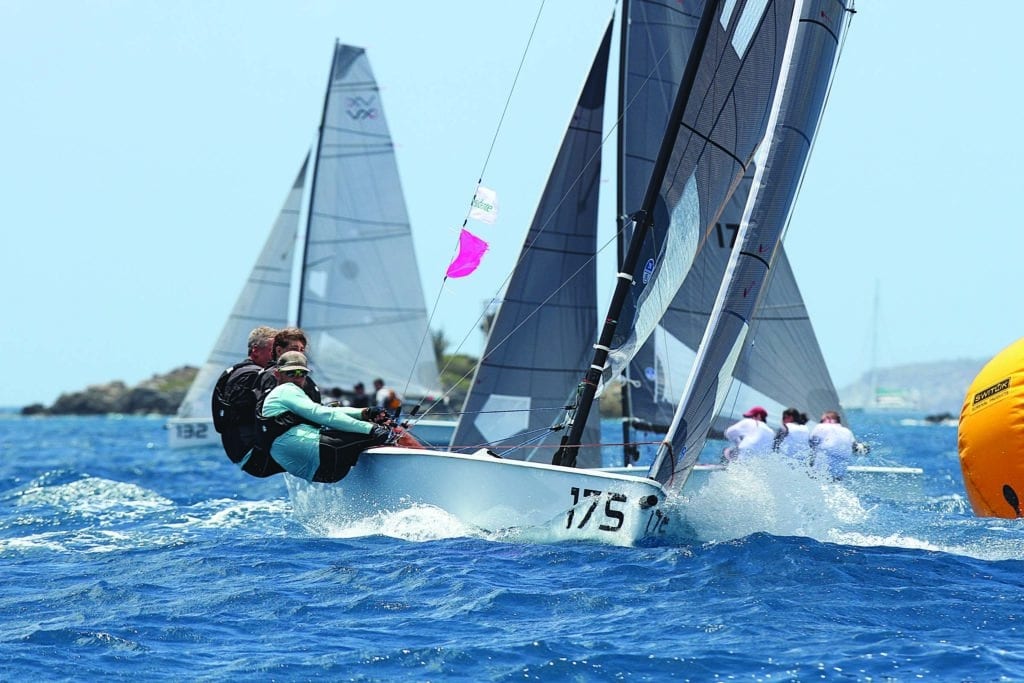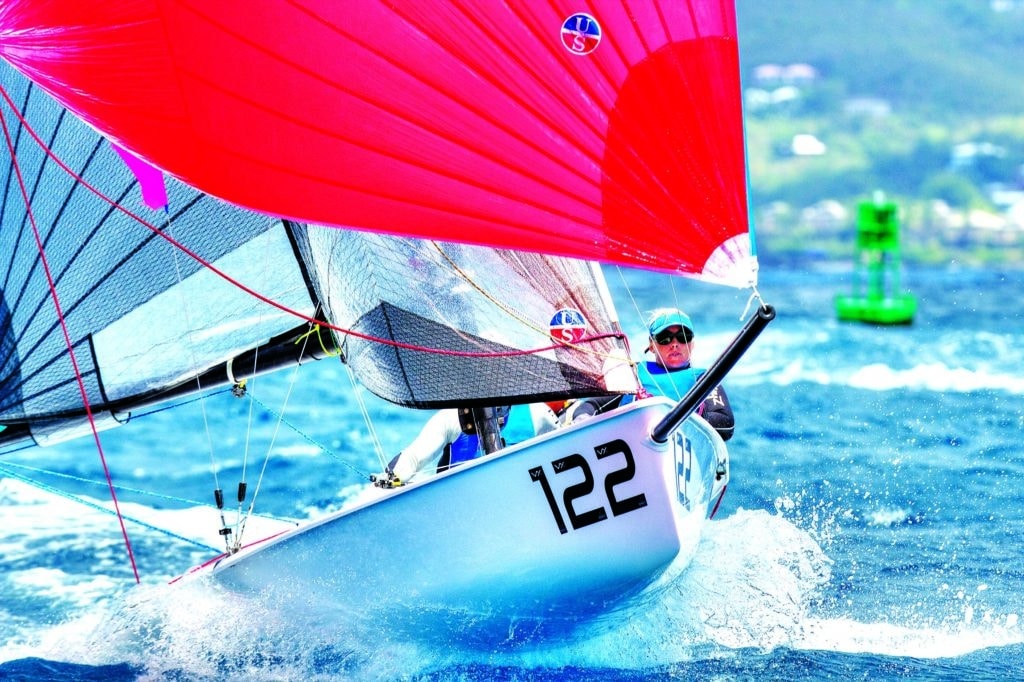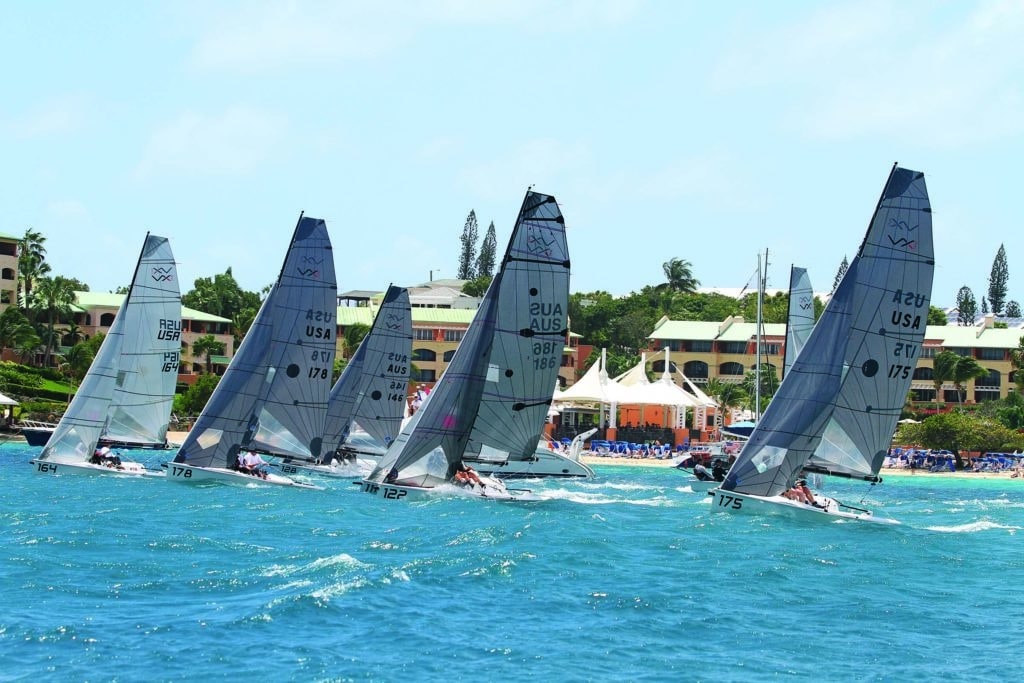
© Stir/Ingrid Abery Photography. ingrid@ingridabery.com +447768 698 316
George Gamble and I are standing in line at U.S. Customs at Cruz Bay. We’re dripping wet, and the water in my sailing shoes squishes with each step as I shuffle forward. Craning my neck to overlook the 50 or so people in front of us, almost all of them comfortably dry, I wonder how long it’s going to be before we’re processed. I look at Gamble and can tell he’s wondering the same thing. We have another 4 miles to reach the St. Thomas YC in Cowpet Bay; it’s already 4 p.m., and the blustery wind that delivered us here is starting to fade. I start to wonder whether we’ll need to find running lights for our little VX One sportboat.
Gamble, from Pensacola, Florida; local islander Kacie Marano; and I are delivering the boat as part of a missionary plan to give sportboat sailors a taste of Caribbean sailing, while also spreading the fast-is-fun gospel in the islands. The mission requires shipping a container of VX Ones from Miami to Tortola, followed by a 15-mile spinnaker sleigh ride to St. Thomas to compete in the St. Thomas International Regatta, then a tow back upwind to Tortola for the BVI Spring Regatta before packing up the boats and sending them back to the States. That’s about two weeks packed with tropical sailing and a whole lot of logistics.
Here in Cruz Bay, we’re in the early stages of the outing, and it’s been a long day already. We left St. Thomas by ferry just after 7 a.m. to arrive at Nanny Cay Marina, in the British Virgin Islands, by midmorning. We should have left from Nanny Cay before noon, but after an entanglement of red tape and snafus at British Customs, we — along with 10 other VX One teams — didn’t cast off for the U.S. Virgin Islands until 3 p.m.
Apart from the unanticipated delays, the delivery to our place in the U.S. Customs line lives up to its hype. Once out of Nanny Cay Resort & Marina, we’re immersed in classic Caribbean sailing conditions: a searing sun, 83-degree air, 80-degree water, and three-foot waves pushed up by 20-knot easterly spring trades piping through Sir Francis Drake Channel. Under asymmetric spinnaker, we huddle as far back in the boat as possible, shoulder to shoulder, with Gamble nearly sitting on the transom. As we plane across the Caribbean Sea, we’re drenched in warm turquoise water, and the boat hums as if it’s wired to an electrical grid.
Marano is new to sailing, and for her, this is truly a baptism by fire. She picks it up quickly, though — a credit to her ability, but also to the boat’s simplicity. The self-tacking jib means she has only one responsibility: keeping her weight aft whenever the bow drops down a wave. Gamble steers while I fly the spinnaker, although there’s not much “flying” in the traditional sense — it’s more like, sheet in, hang on, and don’t let go.

© Stir/Ingrid Abery Photography. ingrid@ingridabery.com +447768 698 316
As with any high-performance boat, weight placement downwind in big breeze on the VX One requires our strict attention. When poorly managed, the result is an instantaneous metamorphosis from raceboat to submarine. Yet even when we’re ankle-deep in the cockpit, the boat quickly shrugs it off, climbs out of a dive, and we’re off again on another tear. “This is so good, it makes me forget all the effort it took to get here,” says Gamble during a pause in the action. That’s affirmative.
The idea of bringing the VX One class to the islands hatched when BVI Regatta organizers approached past Laser Olympian and St. Thomas native Tim Pitts about bringing a sportboat fleet to the region’s two big springtime regattas. “I said absolutely,” says Pitts. “When I first sailed a VX One, I immediately thought about how great it would be to bring the boat to the Caribbean.”
Pitts reached out to VX One designer and importer Brian Bennett, who has a 48-foot car transporter that carries six boats and a 28-footer that carries three. That got the majority of the boats to Bacardi Sailing Week in Miami, from which all 11 could then be shipped to Tortola in 40-foot high-cube containers. At 19 feet, the VX One is at the shorter end of the spectrum, which means more boats per container and thus a lower shipping cost than that of other sportboats. “That really changes what’s possible,” says Pitts. “Economically, you can send your boat to Florida [and] do the Miami event and the two Virgin Islands events for less than $3,000, which is less than what it costs most people just to ship their boats to Florida.”
Bennett Yachting has overseen shipping logistics and set up the boats in Nanny Cay, so by the time we arrive, all that’s left to do is tune the rig, load the sails, attach the rudder, and go. At the opposite end of the tour, the sailors will pitch in to help de-rig, and then Bennett Yachting will take over again, loading the boats and shipping them back to the States. Now that’s concierge service.
“This is really the first time we’ve had a real one-design sportboat fleet in the islands,” says Pitts. “Nobody else could get it together because the cost was so prohibitive.”
The St. Thomas International Regatta is known for its big winds and waves, and this edition doesn’t disappoint.

On the first day of racing, with winds firmly into the mid-20s, VX One skippers huddle to re-evaluate the class’s upper wind-range limit of 22 knots. They agree to raise the bar to 25, which is what they expect for the duration of the regatta. Besides, when the water is as inviting as it is, the wind never seems to be that strong. It would be crazy to come all this way and miss out on three days of ideal racing conditions.
“The class is maturing,” says Pitts, “and we have a wind limit at that point (22 knots) because we’ve been trying to get everyone to get familiar and comfortable with the boats.”
“The boat can handle it,” he adds. As for the competitors’ resilience, that’s a wait-and-see.
It’s a good thing the owners agreed to go for it. Friday’s racing begins with a downwind start that takes the fleet from Cowpet Bay into the Caribbean Sea and west to nearby Charlotte Amalie, where they round a buoy and then sail about half the distance back upwind to the finish. They regroup, restart and continue upwind to the yacht club. Waves are cresting at five feet, and the wind is firmly into the 20s.
“On a couple of the waves, it was like sending the boat down the mineshaft,” says Chris Poole, who is crewing for Don Winston. “You come off the peak, the keel is out of the water, and you’re just diving straight down into the next one. You look over the cliff and think, here we go, boys.”
Australian Nicole Douglass, who is sailing with her father, Rob, and skipper Andrew York describes the experience as “absolutely amazing,” before revealing that their average speed is 20.1 knots, with a top speed eight decimals better. Pitts sees a sustained 21.4 knots for 30 seconds and boasts of a personal best of 22.4 knots. Even after tearing their spinnaker, Pitts and his teammates sail into Charlotte Amalie under main and jib alone at 19 knots. Justin Howard, of Oklahoma, says that he and his crew were still laughing well after they stuffed a wave and blew up their kite. “The boat was just humming,” he says. “Everything was shaking.”
How does one survive such conditions? It’s not so much a matter of survival, says Poole, but rather smart seamanship. “We had a couple of bad flips,” he says, “but my rule of thumb is that once you’re over, dump the spinnaker halyard, which allows the spinnaker to float out across the water. Then, once you get the boat upright and the bow pointed downwind, go right back to full hoist.”

© Stir/Ingrid Abery Photography. ingrid@ingridabery.com +447768 698 316
For every downhill burn, however, there’s the inevitable slog to windward. There are no chairlifts here, but it wouldn’t be a bad idea, either. After sailing, Michael James, on another Australian entry, confesses they pitch-poled a couple of times and agrees that a tow back to the top of the course would have been nice.
Still, everyone returns to St. Thomas YC as speed-satiated as they are sunburned and thirsty. “The downwind is the most fun I’ve had in a boat in 25 years,” says Don Winston, who used to sail catamarans. “And we paid every bit of it back, with interest, in the two upwind legs. We had one true capsize and probably three broaches, but it was doable.”
The next two days of racing feature windward/leeward courses in sheltered water, but winds continue to whistle around the islands. Eventually a few teams cry uncle and elect to stay ashore to nurse injuries, hangovers and sunburns. In St. Thomas, that’s not necessarily a bad thing, because you’re not just here for the regatta; it’s as much about the destination, a laid-back place to hang out with friends in the shade of palm fronds. “To a man, there always comes a point,” says Pitts, “when one seriously contemplates flight changes.”
As ideal as this two-venue dual-regatta concept may be, it does have its challenges. “First is the time crunch,” says Bennett. The window between the VX class’s Miami event in early March and the St. Thomas regatta roughly two weeks later leaves scant margin for shipping delays. “Another week of separation would be good,” he says, considering the feasibility of a 2017 repeat. “It’s going to come down to a class decision about whether they want to forgo the event in Miami.”
Then, of course, there’s the paperwork involved in getting boats into and out of the British Virgin Islands, which must be navigated more carefully next year to avoid this year’s snafus. But these are all hiccups expected of such an ambitious first-time mission, and in the final analysis, the larger impression is the one most remembered. After the final races, a dozen or so VX One sailors sit around small tables pushed together at the St. Thomas YC, swapping stories. Nearby on a dock, one VX is left rigged, sails up, taking local prospects for rides.
By 7 p.m., as the sun finishes its descent, the boat returns from its final demo sail of the evening. The look of satisfaction from those stepping off confirms the sportboat seed has been planted. Whether it survives in this rich foreign soil is uncertain, but for Pitts and his fellow cultivators, there is hope. They’ll simply have to come back and plant another.









